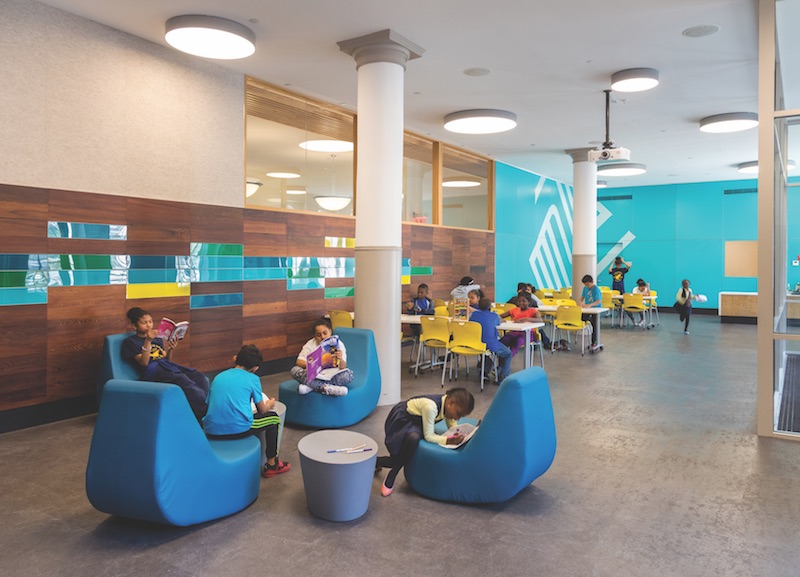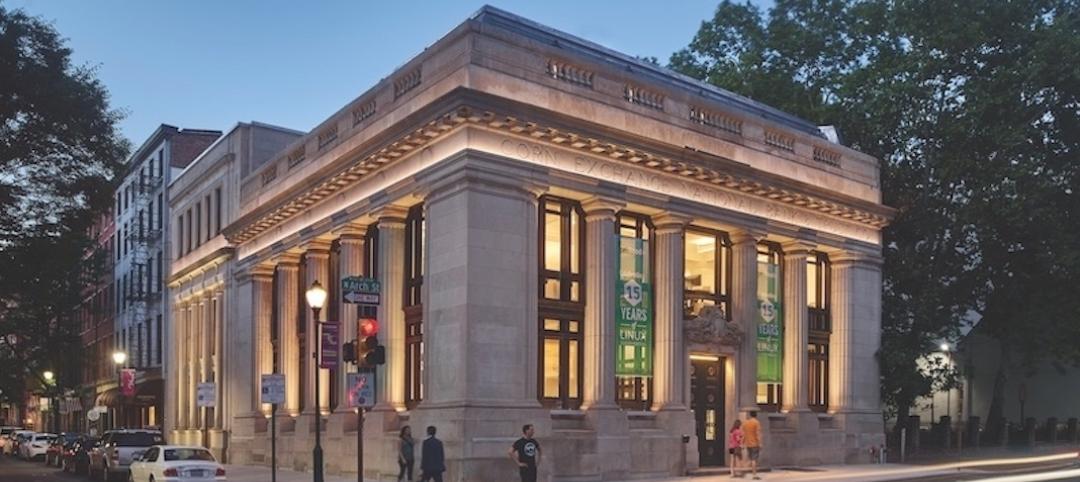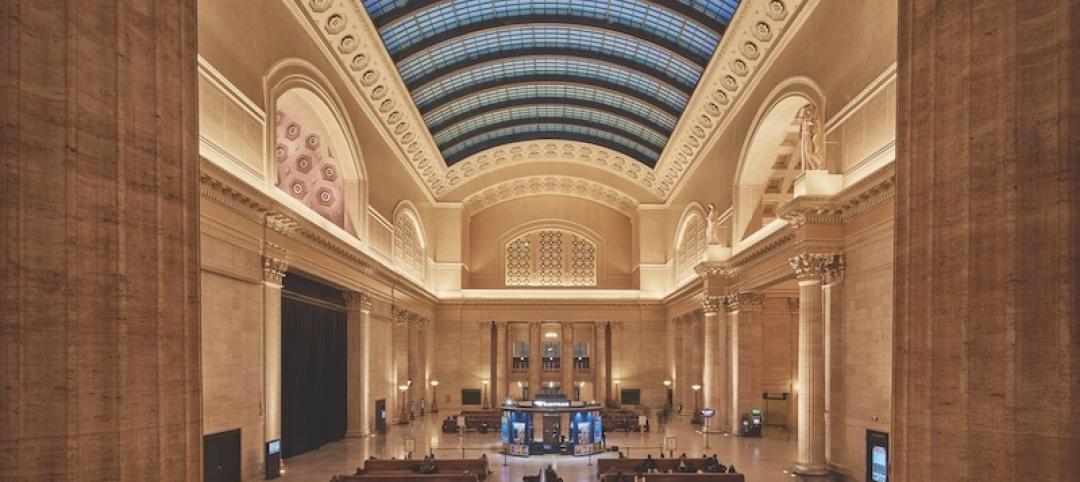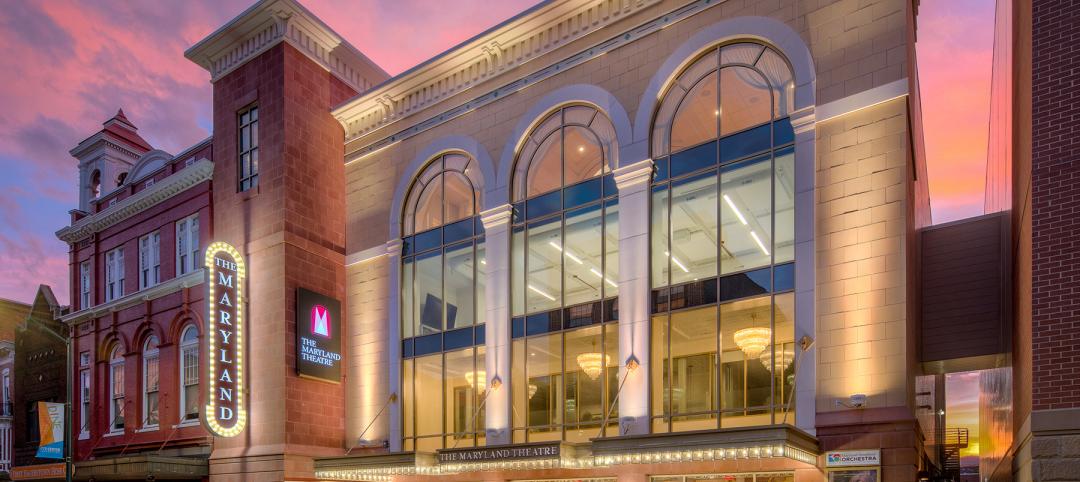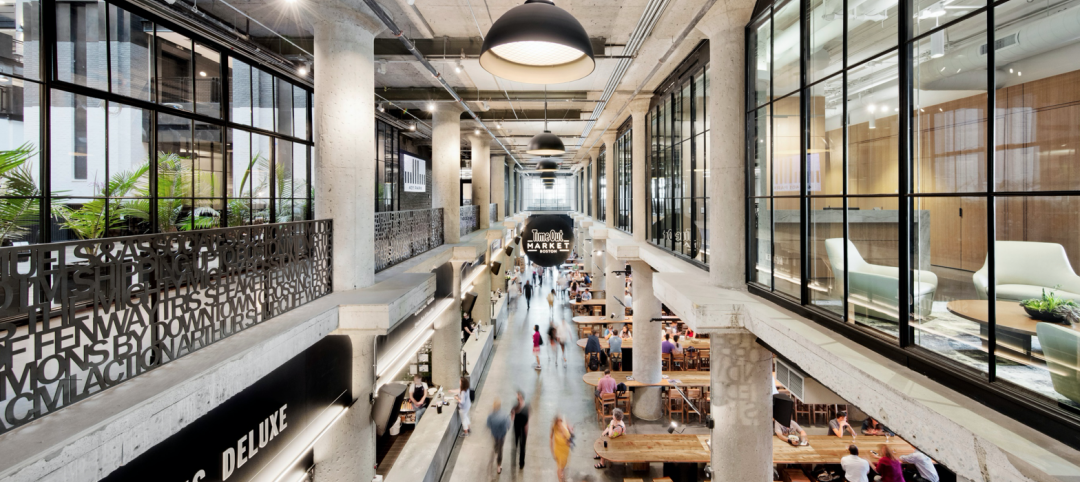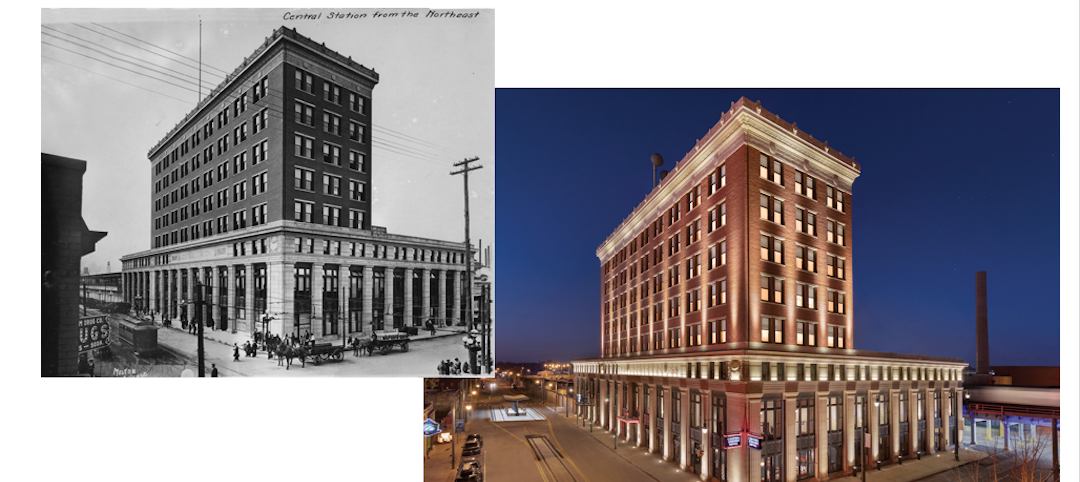The adaptive reuse of PS 186 in West Harlem shows what can be done when imagination and determination come together.
Through the combined efforts of the Boys & Girls Club of Harlem and its development partners, an abandoned public school has been turned into an anchor institution for the Hamilton Heights neighborhood. The adaptive reuse of the 114-year-old school provides two sorely needed services: an 11,300-sf clubhouse with an after-school program and teen center, and 79 units of affordable housing in a neighborhood that is feeling the negative effects of gentrification.
PS 186 was designed by architect Charles B. J. Snyder, Superintendent of School Buildings for the NYC Board of Education from 1891 to 1923. The five-story buff-and-red-brick structure, designed in the Italian Renaissance Revival style, followed Snyder’s signature H-shaped floor plan, which formed open courtyards that brought daylight into the classrooms.
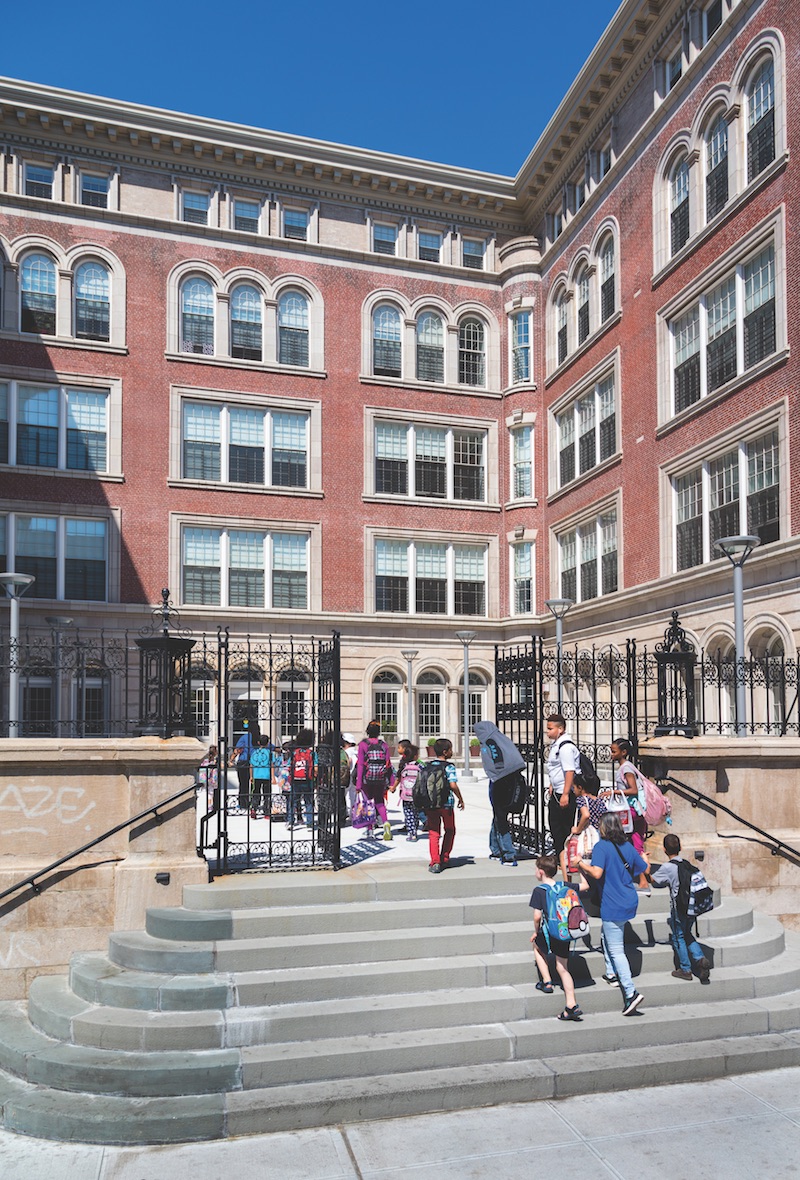 Children enter the Boys & Girls Club of Harlem at the upper courtyard on 145th Street. The decorative metal railings and gates were carefully reconstructed. Another entrance provides an ADA-compliant walkway to the residential quarters.
Children enter the Boys & Girls Club of Harlem at the upper courtyard on 145th Street. The decorative metal railings and gates were carefully reconstructed. Another entrance provides an ADA-compliant walkway to the residential quarters.
Completed in 1903, the school was immediately filled with the children of immigrant families.
PS 186 continued to serve the neighborhood around 145th Street and Amsterdam Avenue for another seven decades, but in 1975 the city declared it unsafe for occupancy, closed it, and transferred the site to the New York County Local Development Corporation. In 1986, the Boys & Girls Club of Harlem (BGCH) bought the property for $215,000.
There it sat for more than two decades. Weeds, even whole trees, clogged the classrooms. Wood floors turned spongy from the damp conditions. Hundreds of pigeon carcasses littered the upper floors. Homeless people squatted amid the ruins. Members of Community Board 9 and the local homeowners association called for the BGCH to take action. Some in the community demanded that the building be razed.
In 2009, the club, in partnership with Alembic Development, proposed a $79 million plan to demolish the school and build a new 200,000-sf home for the group, plus affordable housing, and community and retail space.
Word that PS 186 might be demolished brought out the preservationists, whose letter-writing campaign gained the support of the New York Landmarks Conservancy. But when the community board turned down a bid to have the school declared a landmark, the BGCH claimed that renovating the building without the attendant historic preservation tax breaks was not feasible.
Everything started to change in 2012, as rumors of a plan to reuse PS 186 began to buzz through the streets of West Harlem. In late 2013, Monadnock Construction bought the building from the Boys & Girls Club. Shortly thereafter, Dattner Architects was hired to seek a rezoning for a mixed-use redevelopment with affordable housing and a flagship location for the club. Preservation, once thought impossible, was now the seen as the enlightened path.
What made the deal financially feasible was a conditional approval from the National Park Service stating that PS 186 represented a historically significant example of early 20th-century school architecture. This made it eligible for listing on the National Register of Historic Places and opened the door to what would become about $20 million in historic preservation tax credits.
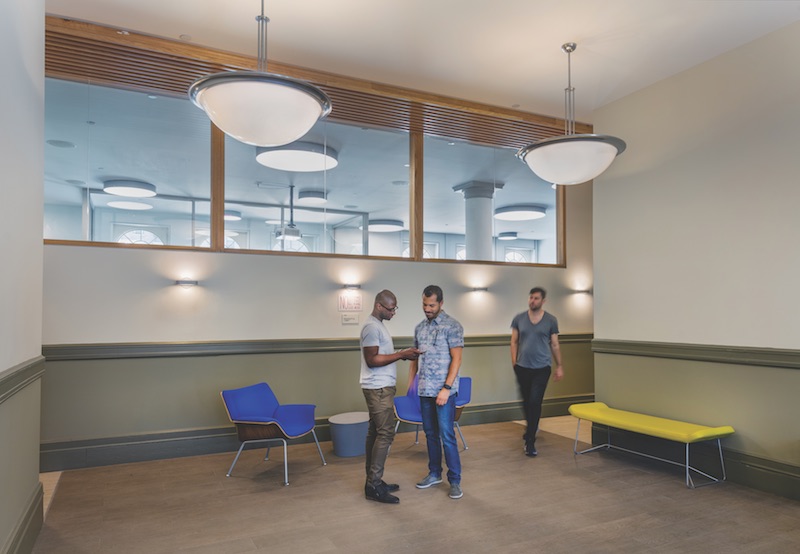 The development provides 79 affordable housing units on its four upper floors: 19 studios, 39 one-bedrooms, 12 two-bedrooms, and nine lofts. Monthly rents range from $508 for a subsidized studio to $2,738 for a market-rate two-bedroom. The 100,520-sf project is participating in the Enterprise Green Communities sustainability program.
The development provides 79 affordable housing units on its four upper floors: 19 studios, 39 one-bedrooms, 12 two-bedrooms, and nine lofts. Monthly rents range from $508 for a subsidized studio to $2,738 for a market-rate two-bedroom. The 100,520-sf project is participating in the Enterprise Green Communities sustainability program.
To comply with the NPS ruling, the reconstruction had to adhere to the Secretary of the Interior’s Standards for Rehabilitation. This meant that the project team had to maintain Snyder’s H-shaped floor plan. Numerous character-defining interior features—ornamental staircases, high ceilings, and a decorative stage known as the principal’s platform—were also preserved.
Key elements of the Italian Renaissance exterior were restored. Based on historic photographs of the original cornice, now damaged beyond repair, the design team worked with a manufacturer to create a support system for a new glass-reinforced cornice. A niche overlooking the historic entry to the school that holds a statue of Minerva, goddess of wisdom and knowledge, also was rejuvenated.
The north and south courtyards were reclaimed. From specimens of existing material, the team reconstructed the decorative iron railings and gates. Stone stairs that had been replaced with concrete block were brought back to their virginal state. An ADA-compliant entry walkway from the street to the residence entry was installed. Two new exit doors were punched out to provide safe egress from the apartment floors (two to five).
Sound attenuation in the residential floors was also addressed. Window units and exterior glass doors were recreated from historic photographs and extant drawings of the school.
Although it took 30 years to complete, the project was applauded by the Reconstruction Awards jury as a shining example of what can be done to bestow new life on the thousands of vacant public schools that face ruin in America’s older cities. Others apparently agree. The project has also won the New York Landmarks Conservancy Lucy G. Moss Award and the Society of American Registered Architects New York Design Award.
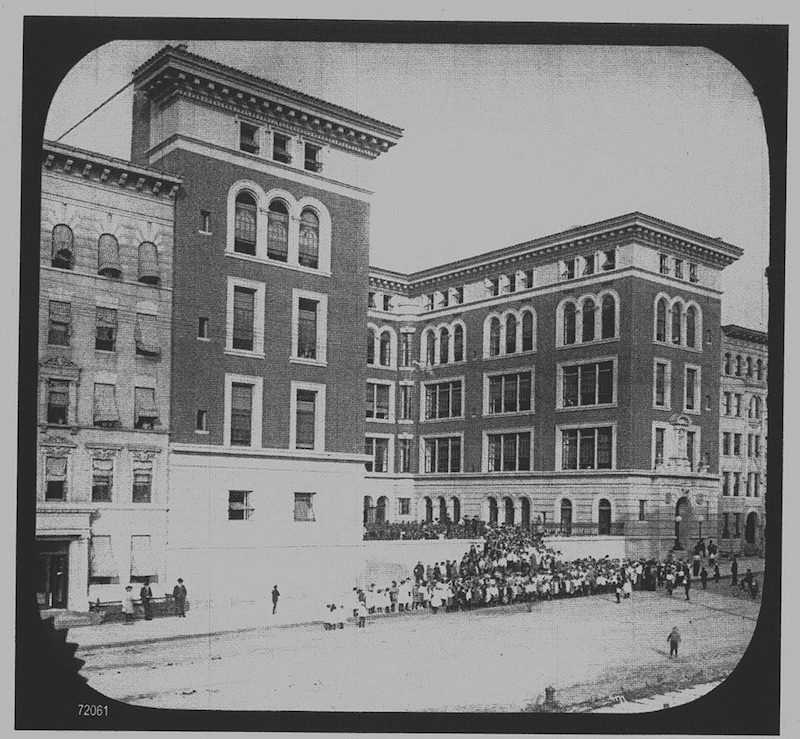 PS 186 opened in 1903 in response to the population explosion in the Hamilton Heights section of Harlem. The school offered adult night classes and became a neighborhood institution but closed in 1975. With its recent renovation, it is back as a community hub.
PS 186 opened in 1903 in response to the population explosion in the Hamilton Heights section of Harlem. The school offered adult night classes and became a neighborhood institution but closed in 1975. With its recent renovation, it is back as a community hub.
Project Sumamry
Platinum Award Winner
Building Team | Dattner Architects (submitting firm, architect, interiors) Boys & Girls Club of Harlem, Alembic Community Development, and Monadnock Development (owners) DeNardis Engineering (SE) Abraham Joselow PC (MEP) Michael A. Tomlan, FAPTI (historic preservation consultant) Construction Specifications, Inc. (specifications) Lumen Architecture (lighting) AKRF (acoustics) JM Zoning (expediting) SWA (sustainability consultant) Jim Harwood Architects (ornamental masonry consultant) Monadnock Construction (GC).
Details | 111,820 sf Total cost $45.4 million. Construction time: March 2012 to October 2016. Delivery method: Design-bid-build.
See all of the 2017 Reconstruction Award winners here
Related Stories
Government Buildings | Jan 9, 2023
Blackstone, Starwood among real estate giants urging President Biden to repurpose unused federal office space for housing
The Real Estate Roundtable, a group including major real estate firms such as Brookfield Properties, Blackstone, Empire State Realty Trust, Starwood Capital, as well as multiple major banks and CRE professional organizations, recently sent a letter to President Joe Biden on the implications of remote work within the federal government.
Giants 400 | Aug 11, 2021
BD+C Awards Programs
Entry information and past winners for Building Design+Construction's two major awards programs: 40 Under 40 and Giants 400
Reconstruction Awards | Mar 12, 2021
Call for entries: 2021 Reconstruction Awards
The 2021 Reconstruction Awards recognize the best reconstructed, renovated, or remodeled projects, based on overall design, engineering, and construction project quality. Entries are due July 16, 2021.
Reconstruction Awards | Mar 12, 2021
2021 Reconstruction Awards Entry Information
Only projects completed or occupied between January 1, 2020 and July 16, 2021 are eligible.
Reconstruction Awards | Mar 12, 2021
2021 Reconstruction Awards 'How to Win' Tip Sheet
Keep this tip sheet handy when preparing your Reconstruction Awards entry, as these are some items on which your project will be judged.
Reconstruction Awards | Feb 5, 2021
The historic Maryland Theatre is reborn in Hagerstown
The Maryland Theatre project has won a Bronze Award in BD+C's 2020 Reconstruction Awards.
Reconstruction Awards | Jan 30, 2021
Repositioning of historic Sears Roebuck warehouse enlivens Boston’s Fenway neighborhood
Developer Samuels & Associates asked Elkus Manfredi Architects to reimagine the former Sears Roebuck & Co. warehouse in Boston’s Fenway neighborhood as a dynamic mixed-use destination that complements the high-energy Fenway neighborhood while honoring the building’s historical significance.


